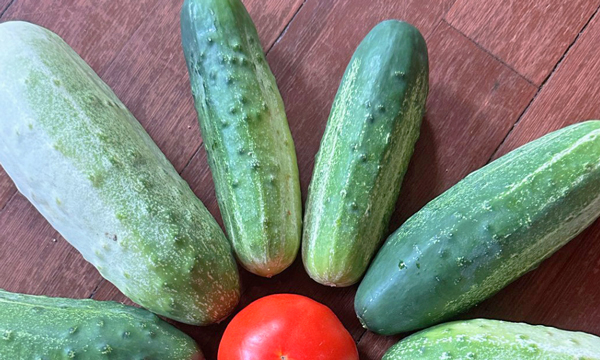Last year, our cucumber harvests were amazing. We jarred many quarts of pickles and relish, and ate cucumbers until we were tired of them.
This is a big step up from previous years, where we often struggled to grow many cucumbers the “normal” way, on trellises and mounds.
Inspired by Joseph Lofthouse’s approach to landrace gardening, a few years ago we mixed up a bunch of pickling cucumber seeds and planted them all together, in the ground, without trellises.
The ones that survived and made fruit, we saved seeds from. We’re now on our third (or maybe fourth) generation of mixed-up cukes, and they are really flying.
Last year was the first year they really shone, and we harvested 163lbs.
That was just one of many loads of cucumbers that travelled through our weigh station.
This is the weigh station, by the way:
It’s been quite helpful and gives us goals to hit and exceed from year to year.
But back to the cucumbers. Here are the first fruits we brought in this year:
View this post on Instagram
There should be a flood of them coming in for the next month or so. Once they start producing, you have to check them every day or they blow up into giant blimps!
Landrace Gardening works.



4 comments
So cool to see your success with those landrace cucumbers!
Are you working on a slicing tomato landrace? I know tomatoes (other than Everglades tomatoes) are a real struggle to grow, so I didn’t know if you were trying or thinking about landracing them.
Let me know if you want few seeds from some of the least fragile slicing tomatoes I’ve grown here in the Florida Panhandle. Hope you don’t mind weird colors! (I would guess that after some years of landracing most of the tomatoes will end up red or pink.)
No, I am not playing with tomatoes since they inbreed, not outbreed. Hard to landrace.
Hi David,
I think I saw on recent videos that you were trying the Kiwana AKA African horned cucumber AKA jelly melon in your garden this year. This article on cucumbers reminded me.
I tried Kiwana for the first time about 4 growing seasons ago. I have found that they do not require their own growing spot and are fantastic to grow under other plants if you are pressed for space in your garden area. For me, they have happily grown under and in competition with my curcubita moschata mixed variety/landrace for 3 years now.
The first year I gave them their own space. It was the second year that a couple of self seeded plants came up under my butternut/mixed cross pumpkin plants, and I noticed that the kiwana plants produced prolifically in spite of the competition.
I deliberately planted them near the pumpkin the third year and again, the kiwana successfully produced many fruit without being given any consideration of space or nutrition.
About 3 weeks ago I harvested season 4 – a couple of plants had got under the mandarine tree and I had fruit growing up in the tree amongst the mandarines (as well as under the pumpkins where I had deliberately planted them). I have more fruit now than I think I can possibly eat in the next 6 months and all without giving them their own space or any attention at all.
Additionally, I find the kiwana to be amazing for storage, which is why I first grew them. I had read, I think Carol Deppe was the author, that they kept perhaps 8 months (if I recall correctly) without special efforts at storage. I have found that to be true. I can, without any special preservation method but simply separating the fruit in flat boxes so they don’t pierce each other, keep the kiwana for eating over winter and spring until only a couple of weeks before the next regular cucumber is expected from the summer garden. I do find that most of the kiwana fruit is produced in autumn, so continue to plan to eat regular cucumbers from early summer through to early autumn.
To eat, I peel the younger green ones with a paring knife and slice to put in salads. They taste very similar to regular cucumber eaten that way. When they get a bit older and the flesh starts to get a yellow hue, I found that at that stage I don’t enjoy eating the flesh around the seeds, so at that stage I scoop the flesh out with a spoon and avoid the firmer yellowing parts.
I hope you will add them to your survival plant profiles. I can safely say that they are now a keeper in my garden.
I am in a somewhat drier climate I think than you, with wet cool winters and hot dry summers. However the Kiwanas have done well even in the recent wetter than average years for me. I hope you have similar success.
Wendy
Thank you. They are running like crazy now. I wondered what they tasted like.
Comments are closed.